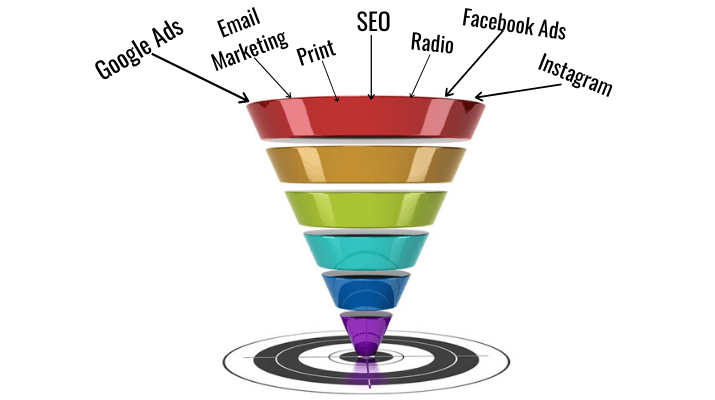“If you can’t measure it, you can’t improve it.” Those are the famous words from Peter Drucker, one of the leading consultants, teachers, and authors that shaped how modern business functions in the twentieth century. You can learn more about Drucker here.
Why Tracking Matters…
Simply put, if you cannot track your marketing and advertising efforts then there’s no way you can track your ROI. If you cannot track ROI, how do you know if your efforts are working?
We’ve mentioned before the importance of not going all-in on SEO or any singular marketing tactic. This is because a diversified marketing approach creates more opportunities for growth, and it protects you when one tactic isn’t performing as well.
The challenge with a diversified marketing approach is that you have all these “balls in motion” and you may even start to see more patients in the door and more revenue, but which tactic was responsible for this growth?
When tracking your marketing efforts, don’t ever rely on your gut feeling when you can leverage irrefutable data to confirm your growth.
Your aesthetic practice’s tracking or “track stack” needs to be as diverse as your marketing efforts themselves. We’ve conveniently broken this into two main categories, on-site and off-site tracking.
On-Site Tracking…
Google Tag Manager is your key tool for your on-site tracking. You’ll want to connect Tag Manager directly with your Google Analytics account, and within it, you can set up:
- Lead Tracking
- Event Tracking
- Pixels
- Structured Data
- Additional Tracking Codes or Scripts
Everything is kept neatly in one place, including tracking codes. This prevents you from having random tracking codes in one CSS file in your website’s backend and another, different script placed in a different CSS file.
In the long run, continuously adding code to your website in different areas can lead to site degradation.
In terms of lead tracking, the two main metrics you need to track are phone calls leads and web leads (form submissions). For those of you utilizing a “chatbot” software or texting platform, you’ll definitely want to set up additional “goals” to track these as well.
You should also track other “events” that are set up as goals, like phone calls and web leads, such as when a mobile user taps for Directions to your practice. Just make sure you don’t “count” these as conversions, or leads, in your reporting.
The next step is ensuring you have the ability to track each “goal” or lead down to the source they came from. Without this step, you cannot delineate a Google Ad lead from an email marketing lead or a Yelp lead.

There are two steps needed to accomplish this:
- You need a website plugin that pulls in the source/medium of each website lead (form submission) based on cookies. Now, keep in mind that 3rd party browser cookies will likely be a thing of the past within the next year, but until that happens, you might as well leverage all the data you can. Simply put, you need a way for your website forms to pass through “hidden fields” that pull in information about where that user came from, and these hidden fields are based on cookies.
- You need to utilize UTM tracking. This means setting up tracking URLs on all of your campaigns, including Google Ads, Facebook Ads, email marketing, Yelp, and anywhere else you’re creating links to drive traffic to your website or landing pages. In many ways, this is a compliment to #1, but when cookies eventually die this will be your key mechanism for tying a name to a source.
What about phone call leads? If you utilize a quality software then you can track phone calls down to the source they came from, even pulling in exact keywords if the lead called in from an ad campaign!

With this tracking in place, you have the ability to identify where both web leads and phone call leads came from.
The last step is feeding your leads into your CRM and your reporting software:
- CRM: such as Turbo’s Sticky Leadz, which has auto-text, email, voice mail follow-up sequences for each type of lead generated
- Reporting software: Google Analytics, Google Data Studio, Google Sheets, and Agency Analytics, to name a few
*Additional Tip: if you don’t have a fancy CRM to feed your web and call leads into then use Zapier to feed in your web leads and phone call leads into a Google Sheet that lists out each name and the source they came from. It’s free!
Off-Site Tracking…
- Site Health: Google Search Console
- Site Uptime: Pingdom
- Site Speed: Pingdom
- SEO rankings: Ahrefs, SEMRush, Agency Analytics, and many more
To be clear, each of these tools monitor your website so they are, in a sense, “on-site,” but they aren’t tied into Google Tag Manager, which is why I’m calling them “off-site” tracking tools. These are complementary solutions that we strongly recommend, not to track results but to track other ancillary, yet important, metrics.
You need to ensure your website is ranking well, doesn’t have broken links, and you need to know if the server it’s hosted on ever goes down. By keeping a pulse on all of metrics you’re ensuring there are no barriers to generating traffic that converts (assuming you’ve got all the other pieces for conversion/lead generation dialed in).
Do You Run a Plastic Surgery, Med Spa, Dermatology, or other Aesthetic Practice and Struggle with Tracking Your Marketing or Advertising Efforts?
TRBO can help with evaluating and improving your “Track Stack.” If you would like to speak to one of our aesthetic marketing specialists here at TRBO ADvance, then drop us a note here. You can also reach TRBO directly at 877-673-7096 x2.







